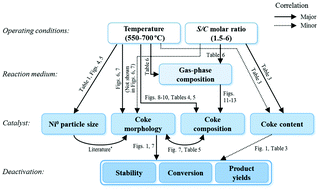当前位置:
X-MOL 学术
›
Green Chem.
›
论文详情
Our official English website, www.x-mol.net, welcomes your feedback! (Note: you will need to create a separate account there.)
Role of oxygenates and effect of operating conditions in the deactivation of a Ni supported catalyst during the steam reforming of bio-oil
Green Chemistry ( IF 9.8 ) Pub Date : 2017-07-14 00:00:00 , DOI: 10.1039/c7gc01432e Aitor Ochoa 1, 2, 3, 4 , Borja Aramburu 1, 2, 3, 4 , Beatriz Valle 1, 2, 3, 4 , Daniel E. Resasco 5, 6, 7, 8, 9 , Javier Bilbao 1, 2, 3, 4 , Ana G. Gayubo 1, 2, 3, 4 , Pedro Castaño 1, 2, 3, 4
Green Chemistry ( IF 9.8 ) Pub Date : 2017-07-14 00:00:00 , DOI: 10.1039/c7gc01432e Aitor Ochoa 1, 2, 3, 4 , Borja Aramburu 1, 2, 3, 4 , Beatriz Valle 1, 2, 3, 4 , Daniel E. Resasco 5, 6, 7, 8, 9 , Javier Bilbao 1, 2, 3, 4 , Ana G. Gayubo 1, 2, 3, 4 , Pedro Castaño 1, 2, 3, 4
Affiliation

|
This work investigates the correlation of the reaction conditions (temperature and steam-to-carbon ratio (S/C)) and the reaction medium composition with the deactivation behavior of a Ni/La2O3-αAl2O3 catalyst used in steam reforming of bio-oil, aiming at sustainable hydrogen production from lignocellulosic biomass. The reaction was performed in an in-line two-step system consisting of thermal treatment of bio-oil at 500 °C for retaining the thermal pyrolytic lignin and in-line steam reforming of the remaining oxygenates in a fluidized bed catalytic reactor. The reforming step was conducted at 550 and 700 °C and S/C ratios of 1.5 and 6. Fresh and deactivated catalyst samples were characterized using XRD, SEM, TEM, TPO, XPS, Raman and FTIR spectroscopy. The catalyst deactivation was mainly due to the amorphous and encapsulating coke deposition whose formation is attenuated when both the temperature and S/C ratio are increased. Although the highest catalyst stability is attained at 700 °C and/or an S/C ratio of 6, Ni sintering is noticeable under these conditions. The encapsulating coke is highly oxygenated, in contrast with the more aromatic and condensed nature of filamentous coke. Based on the correlation between the composition of the coke and the reaction medium, it was established that bio-oil oxygenates are the precursors of the encapsulating coke, particularly phenols and alcohols, whereas CO and CH4 are the possible precursors of the coke fraction made of filaments whose contribution to catalyst deactivation is hardly significant.
中文翻译:

含氧化合物的作用和操作条件对生物油蒸汽重整过程中镍负载催化剂失活的影响
这项工作调查的反应条件的相关性(温度和蒸汽与碳的比(S / C)),并用由Ni / La上的失活行为反应介质组合物2 ö 3 -αAl 2 ö 3用于生物油蒸汽重整的催化剂,旨在从木质纤维素生物质中持续生产氢气。该反应在在线两步系统中进行,该系统包括在500°C下对生物油进行热处理以保留热解木质素,以及在流化床催化反应器中对剩余的含氧化合物进行在线蒸汽重整。重整步骤在550和700℃下进行,S / C比为1.5和6。使用XRD,SEM,TEM,TPO,XPS,拉曼和FTIR光谱对新鲜和失活的催化剂样品进行表征。催化剂失活主要是由于无定形和包封焦炭沉积,当温度和S / C比均增加时,其形成会减弱。尽管在700°C和/或S / C比为6时可获得最高的催化剂稳定性,在这些条件下,镍烧结很明显。与丝状焦的更芳香和更冷凝的性质相比,包封的焦被高度氧化。基于焦炭和反应介质组成之间的相关性,可以确定生物油含氧化合物是包封焦炭的前体,特别是酚和醇,而CO和CH图4是由长丝制成的焦炭馏分的可能的前体,其对催化剂失活的贡献几乎不显着。
更新日期:2017-09-19
中文翻译:

含氧化合物的作用和操作条件对生物油蒸汽重整过程中镍负载催化剂失活的影响
这项工作调查的反应条件的相关性(温度和蒸汽与碳的比(S / C)),并用由Ni / La上的失活行为反应介质组合物2 ö 3 -αAl 2 ö 3用于生物油蒸汽重整的催化剂,旨在从木质纤维素生物质中持续生产氢气。该反应在在线两步系统中进行,该系统包括在500°C下对生物油进行热处理以保留热解木质素,以及在流化床催化反应器中对剩余的含氧化合物进行在线蒸汽重整。重整步骤在550和700℃下进行,S / C比为1.5和6。使用XRD,SEM,TEM,TPO,XPS,拉曼和FTIR光谱对新鲜和失活的催化剂样品进行表征。催化剂失活主要是由于无定形和包封焦炭沉积,当温度和S / C比均增加时,其形成会减弱。尽管在700°C和/或S / C比为6时可获得最高的催化剂稳定性,在这些条件下,镍烧结很明显。与丝状焦的更芳香和更冷凝的性质相比,包封的焦被高度氧化。基于焦炭和反应介质组成之间的相关性,可以确定生物油含氧化合物是包封焦炭的前体,特别是酚和醇,而CO和CH图4是由长丝制成的焦炭馏分的可能的前体,其对催化剂失活的贡献几乎不显着。



























 京公网安备 11010802027423号
京公网安备 11010802027423号